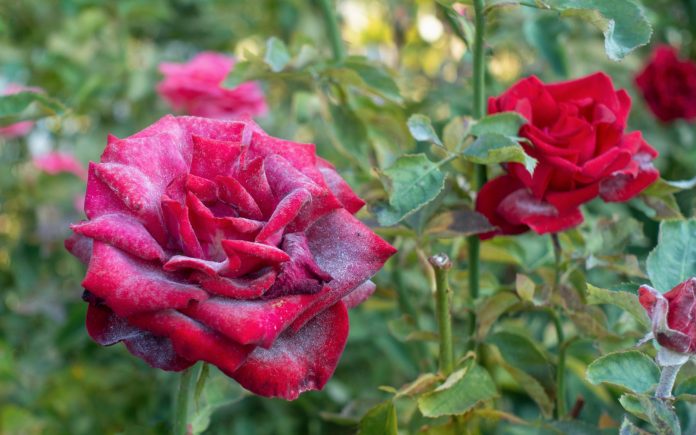
Mildew is every gardener’s worst nightmare, particularly those who have rose bushes. The most known and most frequent mold that impacts rose bushes is one known as sphaerotheca pannosa. This sort of mold is powdery. The mildew is generally a white or gray powder that’s typically found on rose bush leaves, shoots, buds, as well as the petals. Once the mold strikes the plant, it spreads very easily and a gardener will soon notice white spots on the rose bush. The fungus eventually sucks all the water and nutrients in the leaves, which then kills the leaves. The leaves eventually shrivel up and drop from the bush completely.
Powdery Mildew
The common powdery mildew isn’t due to free water on the rose bush’s leaves and other elements; rather the mould lives and thrives on warm, humid weather. In actuality, watering your rose bush in the day will eliminate some of the powdery mildew as it is going to break up the spores which are released by the mould during the daytime. If you can afford to buy fungicides, they’re also helpful in eliminating mildew. However, the fungicide is only going to be effective if you apply it at the ideal time.
Another sort of mildew that’s normal on rose bushes is your Peronospora sparsa fungus. This fungus causes downy mildew, which reverse of powdery mildew, lives in a moist and humid environment. The mould is usually found under the leaves of the rose bush. If you believe your rose bush was infected with a downy mildew, start looking for red, purple, or brown spots on the leaves. This usually ends in the leaves turning yellow and then falling from the bush.
Unfortunately, this sort of mildew isn’t as easily controlled as powdery mildew. Fungicides haven’t proven to be helpful; however, regular rose bush pruning increases air flow, which then reduces humidity surrounding the plant. Regular seasonal pruning is quite important to the health of your rose bush.
Prevention
If you can’t afford to buy fungicides to eliminate mildew, or you simply prefer to not use them, there are a couple of straightforward steps you could follow to decrease the probability of your rose bush becoming infected.
- Before you plant your rose bushes, make certain they are spaced. Hybrid teas should have in minimum, 3 ft. distances and larger bushes should be no closer than 4 ft. Keeping the plants further away from each other enables them to dry out faster after you water them. Lingering water may cause and bring mildew, so spacing is essential. Also make certain your rose bush is getting enough sunlight. Rose bushes that don’t get enough sun will have thin leaves that will be easily taken over by mould.
- Prune till you can not prune anymore! This might be the simplest and most important. Prune whenever your bush requires it. That means year round, not only during the growing season. Pruning your rose bush prevents mould from forming since the plant can get enough air and sunlight that’s spread evenly through the plant helps prevent mould. Pruning a rose bush is extremely straightforward. During pruning season, prune your rose bush by cutting over the new buds. This guarantees that the new growth will be pointed outward rather than inward. Additionally it is important to take time to inspect your rose bush to keep a look out for any forming mould. If you spot any dead or infected areas of the bush, just remove it and throw it out in a sealed container so the mould doesn’t spread.
- When you water your roses, water carefully. To stop the growth of mould, water your plants at root level. This is quite important when it’s hot outside. Avoid getting water on the leaves, particularly in case you water your plants soon before it’s nighttime. If you don’t water your rose bush at root level, the plant will become dehydrated, which is an outcome of mould.
Home Remedy
To save time and money, try this home remedy for rose bushes. Many gardeners, both new and old, use the stinging nettle. This spray is quick and easy to make. All you’ve got to do is collect stinging nettle, place them in a sack, and crush the leaves. Then put the sack in water and let it sit in a warm atmosphere for about a week or so. Then strain the water and dilute it with water. Use this liquid and spray it in your rose bushes every 2 weeks. It’s guaranteed to keep mildew away. If you do not have stinging nettle, you can make a similar spray using these simple instructions:
- 1 tablespoon vegetable oil
- 1 gallon of water
- 1 teaspoon regular-flavored Listerine
- 1 tablespoon liquid soap
- 1 1/2 tbsp baking soda
- 1 tablespoon vinegar
Mix a cup of water with baking soda, Listerine, soap, and vinegar. Add all this to a gallon of water and bad that the liquid into a spray bottle. Shake it up and you are ready to spray!





